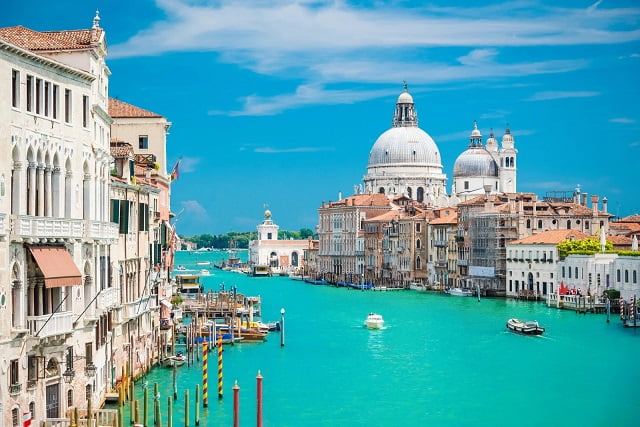Are you planning a trip to Italy and want to learn how to talk about traveling around in Italian? Whether you’re taking public transportation, driving a car, or finding your way through the airport, it’s essential to know key phrases and vocabulary to navigate your way around the country.
In this article, we will explore basic Italian phrases for getting around, using public transportation, renting a car, navigating air travel, asking for directions, making reservations, and more. By the end of this guide, you’ll feel more confident communicating while traveling in Italy.
When traveling in Italy, it’s important to familiarize yourself with basic Italian phrases for getting around. From asking for directions and buying tickets to booking accommodations, having a grasp of common travel vocabulary will enhance your overall experience. Whether you’re a beginner or looking to brush up on your Italian language skills, mastering these essential phrases will make your trip smoother and more enjoyable.
In addition to learning basic travel phrases, we’ll also delve into using public transportation in Italy. Whether you’re taking the metro in Rome or hopping on a vaporetto in Venice, understanding how to navigate buses, trams, trains, and other forms of public transit will be crucial during your time in Italy. So let’s dive into the world of Italian travel vocabulary and start preparing for an unforgettable adventure.
Basic Italian Phrases for Getting Around
When traveling in Italy, it’s important to know some basic Italian phrases for getting around. Whether you’re taking public transportation, renting a car, or navigating the airport, having a few key phrases at your disposal can make your travel experience much smoother. Here are some essential phrases to help you get around in Italian.
Greetings and Polite Phrases
One of the first things you’ll want to know when getting around in Italy is how to greet people and use polite phrases. “Buongiorno” (good morning) and “buonasera” (good evening) are commonly used greetings, while “per favore” (please) and “grazie” (thank you) will come in handy when asking for assistance.
Asking for Directions
When you find yourself needing directions in Italy, it’s helpful to know how to ask. You can simply say “Scusi, dove si trova ?” which means “Excuse me, where is ?” followed by the place or landmark you are looking for. If you need more specific directions, you can ask “Posso arrivare a piedi?” which means “Can I walk there?”.
Making Transportation Inquiries
If you’re using public transportation and need to ask about schedules or stops, knowing a few key phrases can be very useful. For example, if you need to inquire about the next bus or train departure, you can ask “Quando parte il prossimo treno/bus per ?” which means “When does the next train/bus to leave?”.
These basic Italian phrases for getting around will help you navigate your way through Italy with ease and confidence. By familiarizing yourself with these common expressions, you’ll be better equipped to communicate effectively during your travels in Italy.
Using Public Transportation in Italy
Public transportation in Italy is a convenient and efficient way to travel around the country. Whether you’re exploring the bustling city of Rome or the charming streets of Florence, knowing how to navigate public transportation in Italian can make your travels much smoother. Here are some basic phrases to help you get around using public transportation in Italy.
To start, it’s important to know how to ask for information about public transportation. “Dov’è la stazione?” means “Where is the station?” This phrase can be helpful when seeking out a bus or train station. You may also need to ask “Quando parte il prossimo treno?” which translates to “When does the next train leave?” This will come in handy when planning your departure time.
Once you find yourself on public transportation, you’ll want to know how to announce your stop. The phrase “Mi scusi, quale è la fermata per ” means “Excuse me, which is the stop for ” Insert the name of your destination at the end of the sentence to communicate where you need to get off.
Additionally, if you need to purchase a ticket, simply ask “Un biglietto per favore” which means “A ticket please.” These essential phrases will help ensure a smooth and stress-free experience when traveling around Italy using public transportation.
Renting a Car and Driving in Italy
When traveling around Italy, renting a car can provide the freedom and flexibility to explore various destinations at your own pace. When looking to rent a car in Italy, it is important to familiarize yourself with some key Italian phrases that can help you navigate the process.
Basic Phrases for Renting a Car
It is helpful to know how to say “rent a car” in Italian, which is “noleggiare un’auto”. You may also need to ask for information about the rental agreement, insurance coverage, or additional fees. Some useful phrases include “posso avere informazioni sull’accordo di noleggio?” (Can I have information about the rental agreement?) and “è inclusa l’assicurazione nel prezzo?” (Is insurance included in the price?).
Once you have rented a car, it is important to understand the rules of the road and driving etiquette in Italy. While road signs are often international symbols, knowing some basic Italian driving phrases can be helpful.
Common Driving Phrases
Some essential driving phrases include “dove si trova la stazione di servizio più vicina?” (Where is the nearest gas station?) and “posso parcheggiare qui?” (Can I park here?). It’s also important to be aware of speed limits and road regulations by asking “qual è il limite di velocità in questa zona?” (What is the speed limit in this area?).
Overall, renting a car and driving in Italy can enhance your travel experience by allowing you to visit off-the-beaten-path destinations and enjoy scenic drives through the countryside. With some knowledge of basic Italian phrases related to renting a car and driving, you can navigate transportation with confidence during your Italian adventures.
Navigating Air Travel in Italian
Traveling by air is a convenient and efficient way to get around Italy, especially when you need to cover long distances in a short amount of time. Whether you’re flying domestically or internationally, it’s essential to be familiar with some basic Italian phrases and vocabulary related to air travel. Here are some useful phrases to help you navigate air travel in Italian:
- “Passaporto, per favore” – Passport, please
- “Biglietto d’aereo” – Plane ticket
- “Volare” – To fly
- “Bagagli” – Luggage
- “Orario di partenza” – Departure time
- “Porta d’imbarco” – Boarding gate
- “Controllo passaporti” – Passport control
When traveling through airports in Italy, it’s important to be able to communicate effectively with airport staff and understand important announcements. Learning these key phrases will ensure a smoother and more enjoyable air travel experience.
In addition, if you have specific dietary requirements or need special assistance during your flight, it’s crucial to know how to communicate these needs in Italian. For example, if you have a food allergy or require a wheelchair at the airport, knowing how to convey these requests in Italian can make your travel experience more comfortable and stress-free.
Remember that being able to speak some basic Italian while navigating air travel in Italy can also open up opportunities for making new connections with locals and immersing yourself further into the culture. So take the time to learn and practice these essential phrases before your next trip.
Asking for Directions in Italian
When traveling in Italy, it is important to be able to ask for directions in Italian. Whether you are trying to find a famous landmark, a restaurant, or your hotel, having some basic phrases at your disposal can be extremely helpful. Below are some essential Italian phrases to use when asking for directions:
- Excuse me, where is the (train station/restaurant/bathroom)? – Mi scusi, dove si trova la (stazione ferroviaria/ristorante/bagno)?
- Can you tell me how to get to (the Colosseum/the Duomo/the Vatican)? – Mi può dire come arrivare al (Colosseo/Duomo/Vaticano)?
- Is it far from here? – È lontano da qui?
- Which way is (north/south/east/west)? – In quale direzione si trova (nord/sud/est/ovest)?
It’s important to remember that using polite terms such as “mi scusi” (excuse me) and “per favore” (please) will go a long way when asking for directions in Italian.
| Italian Phrase | English Translation |
|---|---|
| Sinistra/destra | Left/right |
| Dritto | Straight ahead |
| Vicino/lontano | Near/far |
Making Reservations and Booking Accommodations
Booking accommodations and making reservations in Italian can be an essential part of planning a trip to Italy. Whether you are looking for a hotel, vacation rental, or bed and breakfast, it is important to know the key phrases and terms to use when making arrangements for your stay.
When booking accommodations in Italy, you may need to know how to ask about room availability, inquire about amenities, and confirm reservation details. It is helpful to learn phrases such as “È disponibile una camera per stasera?” which means “Is a room available for tonight?” and “Quali sono le dotazioni della camera?” which translates to “What are the room amenities?”.
In addition to booking accommodations, it is also important to make reservations at restaurants or for tourist attractions during your travels. Phrases like “Vorrei prenotare un tavolo per due persone” (I would like to book a table for two) or “Vorrei prenotare due biglietti per il Museo del Louvre” (I would like to book two tickets for the Louvre Museum) can come in handy when planning your itinerary.
It is essential to remember that making reservations and booking accommodations in advance is common practice in Italy, especially during peak travel seasons.
Useful Italian Travel Apps and Resources
Italy is a beautiful country to visit, and having the right apps and resources can make your travel experience even more enjoyable. Whether you are looking for language translation apps or navigation tools, there are plenty of options available to help make your travel around Italy smoother and more convenient.
Here are some useful Italian travel apps and resources to consider:
- Google Maps: This is a must-have app for anyone traveling around Italy. It provides reliable navigation, public transportation information, and even walking directions in Italian cities.
- Duolingo: If you want to brush up on your Italian language skills before or during your trip, Duolingo is a great language learning app that can help you learn how to say travel around in Italian and other essential phrases.
- Trenitalia: This app is essential if you plan on using trains as your main mode of transportation in Italy. You can use it to check train schedules, buy tickets, and access real-time updates on delays or cancellations.
- Airbnb: For unique accommodation options beyond traditional hotels, Airbnb offers a wide range of options throughout Italy. From modern apartments in Rome to charming villas in Tuscany, this platform is a great resource for finding accommodations that suit your preferences.
These resources will not only help you navigate through Italy with ease but also enhance your travel experience by providing valuable information and services at your fingertips. With the right tools at hand, you can focus on enjoying all the wonders that Italy has to offer.
Cultural Etiquette and Tips for Traveling in Italy
In conclusion, traveling in Italy can be an enriching and immersive experience, especially when armed with a good grasp of the local language. In this guide, we have covered essential Italian travel vocabulary and phrases for getting around, using public transportation, renting a car, navigating air travel, asking for directions, making reservations, and accessing useful travel resources. However, one crucial aspect of traveling in Italy that cannot be overlooked is understanding the cultural etiquette and tips for interacting with locals.
As visitors to Italy, it is important to familiarize yourself with the customs and social norms of the country. Italians value politeness and respect in their interactions, so being courteous and using proper greetings can go a long way in fostering positive relationships. Additionally, understanding dining etiquette and tipping practices can enhance your dining experiences while traveling in Italy.
Furthermore, embracing the Italian way of life by engaging with locals and immersing yourself in the culture can lead to meaningful connections and memorable experiences. Ultimately, by showing genuine interest in Italian customs and traditions, travelers can deepen their appreciation for this beautiful country. By learning how to say travel around in Italian and familiarizing oneself with cultural etiquette, anyone visiting Italy can enjoy a more fulfilling and authentic travel experience.
Frequently Asked Questions
What Is the Verb for Travel in Italian?
The verb for travel in Italian is “viaggiare.” This is a common verb used to indicate the action of traveling from one place to another, whether it’s by car, train, plane, or boat.
Do Italians Say Bon Voyage?
Italians do not say “bon voyage” as this is a French expression. Instead, they typically use the phrase “buon viaggio” when wishing someone a good trip or safe travels. This is the equivalent of saying “have a good trip” in English.
How Do You Say Trip in Italy?
In Italy, the word for trip is “viaggio.” This can refer to any kind of journey or excursion, whether it’s for leisure, business, or any other purpose. Italians might also use terms like “gita” or “escursione” to refer to a trip or outing.

I’m a passionate traveler, writer, and Italophile. My fascination with Italy’s history, art, and culture has led me on countless adventures across the Italian landscape. Through “I Live Italy,” I share my love for this extraordinary country and aims to inspire others to explore its boundless beauty.





